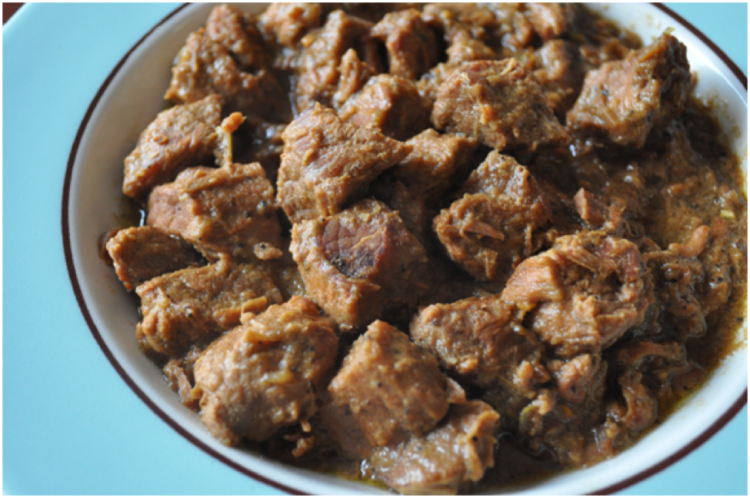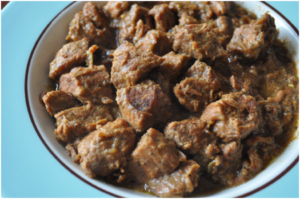
Here at midEATS, we like to bring you authentic Middle Eastern recipes directly from the kitchens of traditional home cooks and chefs all over the world. For today’s post, Eman, an Egyptian cook extraordinaire from Chicago, shares with us how to make a traditional beef pot roast, using sustainably raised meat. Eman loves making traditional meals for her family, and recently, she has been making conscious choices about her food sources. In this post, she shares a little bit about her love for Egyptian cooking, and links some thought-provoking articles about the importance of eating grass-fed meats.
– Heba of midEATS
Kabab Hallah and the Importance of Pastured Meats
By Eman Hassaballa
Kabab hallah literally means cubed meat made in a pot (kabab referring to the cubed meat, and hallah literally meaning ‘pot’ in Arabic). I guess the American version of this would be pot roast, and it’s fairly similar. In terms of comfort food, kabab hallah is definitely near the top of the list. Growing up for us, kabab hallah was for ‘azayim (literally in Arabic this means ‘invites’, but in Egyptian colloquial, it means ‘parties’ usually in reference to big dinner parties). And after making it today, I realize why it’s only saved for special occasions: it takes a long time to make! But it’s delicious and definitely something you will add to your repertoire of recipes.
Before I begin, I have to give a shout out to my in-laws for sharing such a simple and delicious recipe. I have big shoes and a big belly to fill. I usually make kabab hallah with chicken, because my husband doesn’t like red meat; but today for the first time, we used beef and this time, it was bit different: we used organic, pasture-fed beef. I bought the meat from Thankful Harvest, a family farm in Iowa with stellar farming practices. Ever since I started the Recovering Fattict, I’ve been trying to boost my health, and eventually found myself reading the work of Dr. Mary Enig and Sally Fallon Morell, Nourishing Traditions and Eat Fat Lose Fat – and these resources really have changed my relationship with food forever.
Why is pastured (or grass-fed) meat better for you? Eating organic sometimes isn’t enough when it comes to meat and eggs. Cows were never meant to eat grain; their bodies are not designed for it, and they aren’t able to digest it properly. God designed cows as grazing animals, so they are naturally meant to eat grass. Until the turn of the century, evolution has worked in humans’ favor – cows ate grass, and when we ate beef, we also received the omega-3s abundantly present in their meat. Over the past few decades when agribusiness became large-scale and industrialized, farmers started to feed cows grain (mainly corn and soy, and a lot of it being genetically modified), thereby affecting the nutritional content of the meat that we eat! When cows eat grain, the fat in the meat is the not the healthy fat that our body needs. Pasture-fed beef is lower in calories too. It’s also better for the environment. And I am barely glossing the surface of why it is so beneficial to eat pasture-fed meats and eggs! If this topic has piqued your interest and you’d like to find out more, you can read more about it in this Time article titled “How Cows (Grass-Fed Only) Could Save the Planet”, on Dr. Mercola’s website, and in this Weston A. Price Foundation article about the importance of pastured poultry.

| Prep Time | 10 minutes |
| Cook Time | 3 hours |
| Servings |
|
- 1 lb stew meat (preferably 100% grass-fed beef)
- 1 tbsp grass fed ghee
- 1 large garlic clove (or two small ones)
- 1 small onion
- 1 1/2 tsp fresh cracked black pepper
- 1 pinch cinnamon
- 2-3 cups water or homemade chicken/bone broth (you may need more to add to the meat if it gets dry)
- salt for taste
- 1/2 serrano or jalapeño pepper (Note: This is totally optional. I would actually leave it out, and it’s not necessary, but the original recipe includes it because my husband loves it. The spicy taste should really come from the black pepper; in my opinion, the serrano peppers could distract from the taste of the meat)
Ingredients
|

|
- If your meat is frozen, the best way to thaw it is to submerge it in cold water for a few hours.
- Chop the onions, garlic, and hot peppers and add them to the pot along with the samna baladi on medium high heat. The finer you chop the vegetables, the better, because it will yield a better sauce.
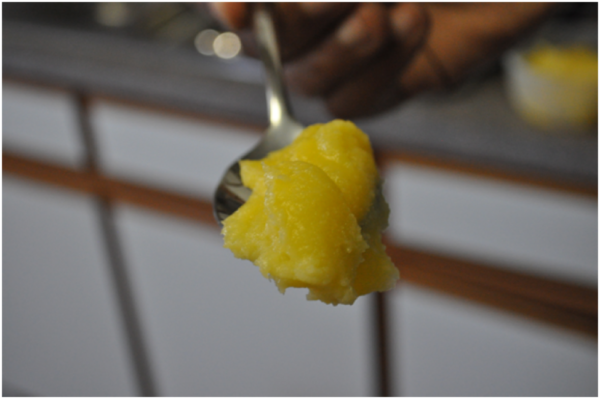
- Add the spices and stir thoroughly. When the onions are translucent, add the meat to the pot and stir everything to get it all happy together and incorporated.
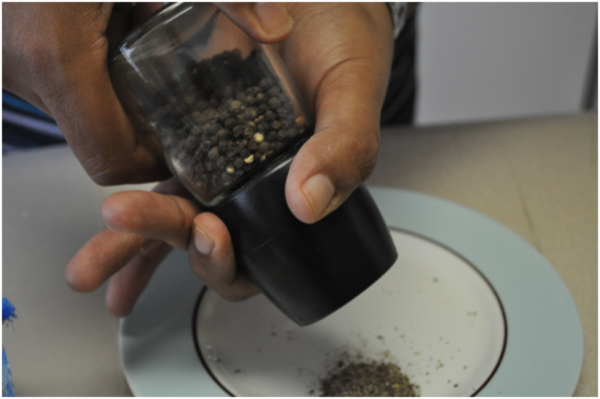
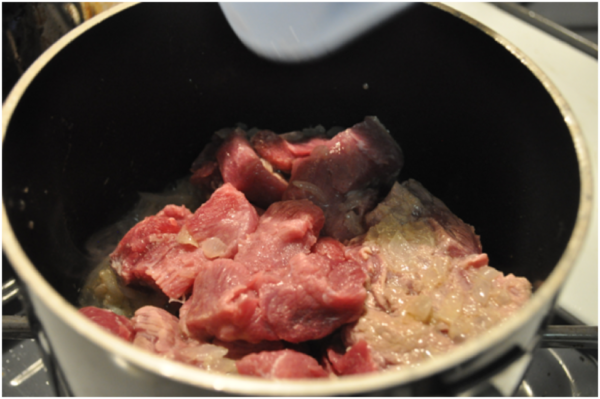
- Add one cup of broth or water and allow it to come to a boil. Then turn the heat to medium low, cover the pot, and let simmer until the meat and the sauce almost become one. That should take about three hours or so. The meat cubes should be still intact, but starting to look soft. Then you know it’s ready. Be sure to add broth or water every so often, so that it doesn’t get dry.
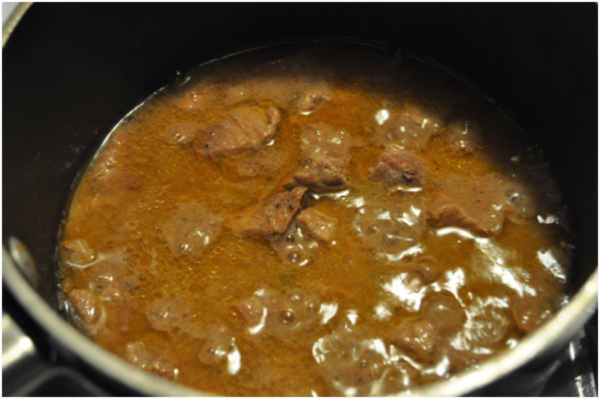
- Note: I usually avoid using Maggi bouillon cubes, for the reasons Brenda outlined in her article on the evils of Maggi, but I did use a cube for this recipe because my husband insists it gives the meal a stronger flavor. If you can use bone broth, homemade chicken broth, or even water instead, that would be ideal!
- Salt should go in near the very end if at all, so that the meat cooks thoroughly and the flavor isn’t too salty. Enjoy with bread or rice and say a little prayer for me.
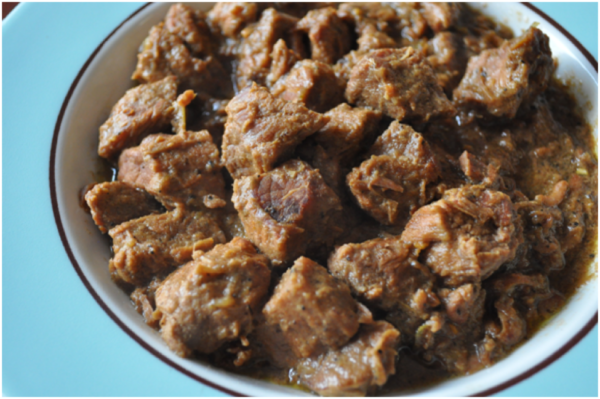
Guest Post: Eman Hassaballa
I want to thank my husband for being my sous-chef and hand model so I could focus on taking pictures!
About the Cook

Eman Hassaballa Aly resides in the suburbs of Chicago with her husband, no kids and no pets. She loves to eat, eat, eat and cook (in that order). In addition to eating, she works in public health research and also works as a mental health counselor at The Heartspeak Institute. She’s been publicly tackling her issues with food and weight at The Recovering Fattict. She still aspires to become a pastry chef and marry her two passions by opening up a therapy cafe. Her current culinary adventures include opening up a pizza restaurant, Eshticken Pizza, in Hoffman Estates, Illinois.

